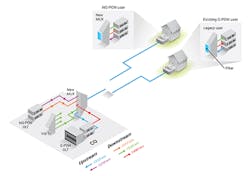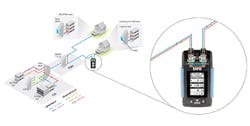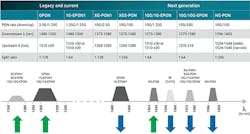PON Testing for Legacy and Next-Gen Technologies —
With gigabit broadband now becoming a bare essential, as well as the opportunities presented by business services and 5G small cell support, service providers are starting to consider upgrading their current fiber architectures with next-generation PON equipment. This article looks at what operators should know to ensure their infrastructures can support such an evolution.
In today’s FTTH networks, there usually is a feeder fiber (called F1) leaving the central office (CO). This link can sometimes be as long as 30 kilometers. This fiber will feed a splitter that will typically feed 32 fibers, each one connected to an individual house. These are called the F2 fibers. (See Figure 1.)
Figure 1. Typical PON network technology.
Whether it is next-generation PON, legacy, or slower speed FTTH, the Number One fiber-related issue found in the field involves dirty or damaged connectors. Contaminated connectors may induce loss/or reflectance and so connector quality is critical.
The second major type of problem involves physical issues with the fiber itself, for example stress on the fiber (such as a tie wrap used to attach fibers, a tube that is kinked, etc.).
InvisiLight® Solution for Deploying Fiber
April 2, 2022Go to Market Faster. Speed up Network Deployment
April 2, 2022Episode 10: Fiber Optic Closure Specs Explained…
April 1, 2022Food for Thought from Our 2022 ICT Visionaries
April 1, 2022Many industry white papers discuss the importance performing these basic validations (connector cleanliness and fiber characterization) regardless of network topology (i.e., not specific to FTTH and PON). For the purpose of this discussion, let’s focus primarily on PON, and by extension, next-generation PON challenges and solutions.
Data from the house, typically called the optical network termination (ONT), features 2 characteristics that make it complicated to measure and validate:
Characteristic #1: At the installation phase, an ONT is typically in keep-alive mode and emits in short bursts, meaning that the upstream transmission is not continuous. As such, standard power meters are not capable of measuring the power coming from an ONT.
Characteristic #2: An ONT transmits upstream only if it receives a downstream signal from the CO (typically called the optical line termination or OLT). To measure the power in both directions, the ONT has to receive enough power and emit properly. A regular power meter (not pass-through) would not be able to measure power issuing from the ONT as it would no longer be receiving the downstream signal from the OLT and consequently would not be emitting.
PPM Evolution
For such reasons, in the early 2000s, the test and measurement industry developed passthrough PON-specific power meters (PPM) that can measure burst (i.e., fine-tuned to detect the specific burst mode of available PON technologies). Consequently, there are 2 fiber connections on the unit so that, when a PON power meter is inserted into the network, most of the signal continues to go through, enabling the network to still be operational, yet filtering out a given portion of the signal to conduct power measurements. Since transmission is bi-directional (from the CO to the house in continuous mode, and from the house to the CO in burst mode) such PON power meters can, with the proper set of internal tap and filters, simultaneously measure power in both directions. (See Figure 2.)
Figure 2. Pass-through mode in PON power meter.
In legacy GPON this is quite simple, as there is only 1 wavelength (1310 nm) coming from the house, and 1 (1490 nm), sometimes 2 when the 1550 nm wavelength for RF is added, coming from the OLT. Wavelength filtering is therefore not required upstream, and minimally required downstream to separate the 2 wavelengths.
Next-generation PON introduces advantages such as higher bandwidth and higher split ratio, but complicates things by adding several possible wavelengths, both upstream and downstream, as seen in Figure 3.
Figure 3. Legacy, current, and next-generation PON details.
The wavelength filtering offered in standard PPMs is limited. In that case, if more than 1 wavelength or signal reaches a detector, either upstream or downstream, that detector provides the total of both — giving the user no way of knowing if one or the other wavelength, therefore the service, is working properly.
Each technology has its own set of upstream and downstream wavelengths. But since multiple technologies can co-exist, a test tool that can discriminate between all these wavelengths and technologies is now required — one that can still detect several burst modes as well as offer pass-through capability.
Furthermore, NG-PON2, a next-generation PON technology, while having a specific wavelength band, uses bandwidth to send multiple wavelength-dependent signals as shown in Figure 4. This is called wavelength division multiplexing PON (WDM-PON) in a very narrow transmission band. This process can significantly increase the number of wavelengths downstream. And again, each one needs to be measured individually with a pass-through device and at reasonable cost to the operator. Cost reduction is made easier since not all the capabilities of a full-blown optical signal analyzer (OSA) are required for FTTH deployments.
Figure 4. NG-PON2, a next-generation PON technology, uses bandwidth to send multiple wavelength-dependent signals.
One such tool is EXFO’s PPM-350D next-generation PON power meter. It can test both legacy and next-generation PON technologies (EPON, GPON, XG-PON, XGS-PON, 10G-EPON, NG-PON2). Its PON-aware™ technology automatically detects the PON technology in use, either legacy or next-generation, and applies the related thresholds, eliminating the confusion multiple coexisting wavelengths can cause in order to deliver error-free testing.
Like this Article?
Subscribe to ISE magazine and start receiving your FREE monthly copy today!
Next-generation PON technologies are an advantageous evolution of current PON technologies as they support more customers delivering more bandwidth. The key is to have the right tools to ensure proper testing to avoid bad surprises and expensive troubleshooting after the fact.













